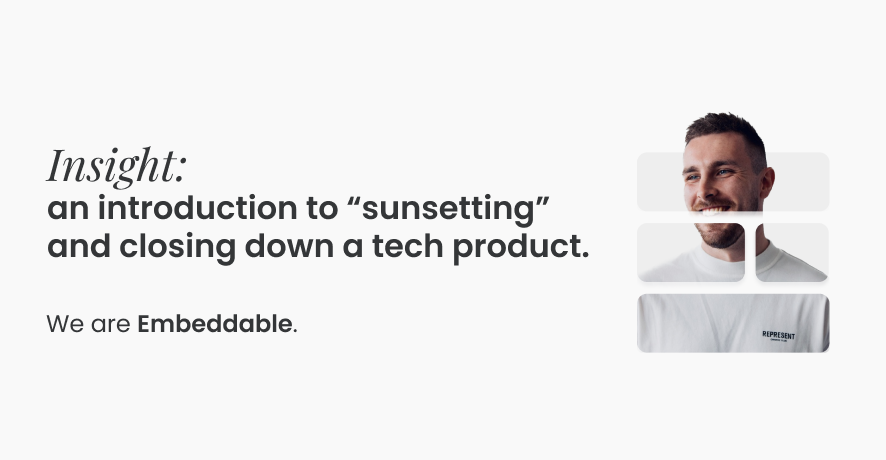Building and launching a product can be an exciting and rewarding process. Your investment has brought a product to market or integrated new technology into your processes with the belief that it will potentially save time, generate income, or improve the experience of your users.
With careful planning, avoiding the potential pitfalls of building tech, your product will hopefully serve as a valuable part of your business for years to come.
Eventually, though, the vast majority of tech follows the proverb “what goes up, must come down” in that it will, at some point, be superseded by something new, or fail to deliver on its purpose.
In both instances, you’ll likely need to go through the process of sunsetting (closing your technology). That can include migrating to a new solution or simply yet gracefully removing the technology from service with no direct replacement.
Knowing when it’s time to sunset
Before you can close down any piece of technology with minimal disruption, the decision needs to be made that it’s the right thing to do. Typically, this is when any of the following apply:
- You have developed a new solution that will replace the existing product.
- Your technology no longer delivers on its core purpose in a cost-effective way, cheaper yet directly comparable alternatives may now be available, or your core costs have increased.
- Your product has been superseded in the market and you are not able to continue to drive it forward, leading to a decline in use.
- Your product has not met the core goals or measurables that you set out, which most often applies to minimum viable products and early-stage developments that do not want to risk further investment.
- Your business has been acquired or is closing and there is no longer a requirement for your product.
This list isn’t exhaustive but covers some of the most common reasons that a product goes through a sunset.
Planning your product’s closure
Having made the decision that your technology is at a point where sunsetting is the best option, there are some key points to consider.
Sunset Duration
Most technology can’t just be switched off. Even with declining use, there is a level of reliance on your technology until customers, clients, or staff have been migrated to a new solution or have been given adequate time to source their alternative.
A typical sunset period is three months or longer, as this provides suitable notice for:
- Users who consider your product as mission-critical to suitable source an alternative, or to begin preparation for using your new product.
- Infrequent and inactive users to access any information you hold before their access to it through your system is removed through the sunset.
Launching in Parallel
For businesses releasing replacement technology, you need to consider the actual launch of your new product, migrate existing data, and provide training to any users as required.
In these instances, a new product and an old product are often run in parallel for a short period, with the data from the old system regularly synced into the new one. The benefit of this is it gives people the familiarity of a current solution whilst also gaining exposure to the new one. At the same time, it gives your team a chance to find and solve any real-world bugs and edge cases that may have been missed in pre-release testing.
Access To & Retaining Data
Even after a product has closed, you may still need access to the underlying data for a multitude of reasons. Including any requirements to retain and report on data, dependent on where you’re located. Ensuring that after a product has been sunset, you retain a copy of any appropriate information is crucial.
In the case of a product closing with no replacement, you must ensure that any information, such as personally identifiable information, that is no longer relevant, is erased in an appropriate timeframe.
Refocusing Your Team
When a product is discontinued, there becomes very little need for continued development beyond routine maintenance and security fixes.
As such, any internal hires in your technology team that were primarily committed to your soon-to-be-sunset product will need to be reallocated to new projects shortly. Once you begin the process of planning a sunset, understanding your team’s objectives going forward and where their time will be invested is crucial.
Closing Down & Securing Supporting Services
Any piece of bespoke technology typically has additional services that underpin it – from SSL certificates, hosting, and infrastructure to third-party APIs and integrations. These services often accumulate over time, tend to renew automatically each year, and can quickly become a sizeable cost.
Ensuring that once a product has completed its sunset, any dedicated servers or virtual machines are repurposed or powered down is key to ensuring that you’re not stung by continuing charges for tech that’s no longer accessible.
For businesses launching a replacement solution, it’s recommended that you use this as an opportunity to rotate any API keys and ensure that your new product uses new tokens or codes for sending and receiving data from integrations.
You’re not alone
In certain instances, sunsetting can be a difficult process. Particularly when it involves a product that has not delivered on its expectations. Sunsetting happens at the highest level of tech companies, with Google having a ruthless reputation for sunsetting any product that does not reach expectations or no longer aligns with their direction. So much so that there’s a website dedicated to keeping tabs on Google’s tech closures.
If you’re beginning to consider sunsetting a product, either to replace it with new technology or to gradually remove it from your business offering, Embeddable can help.
